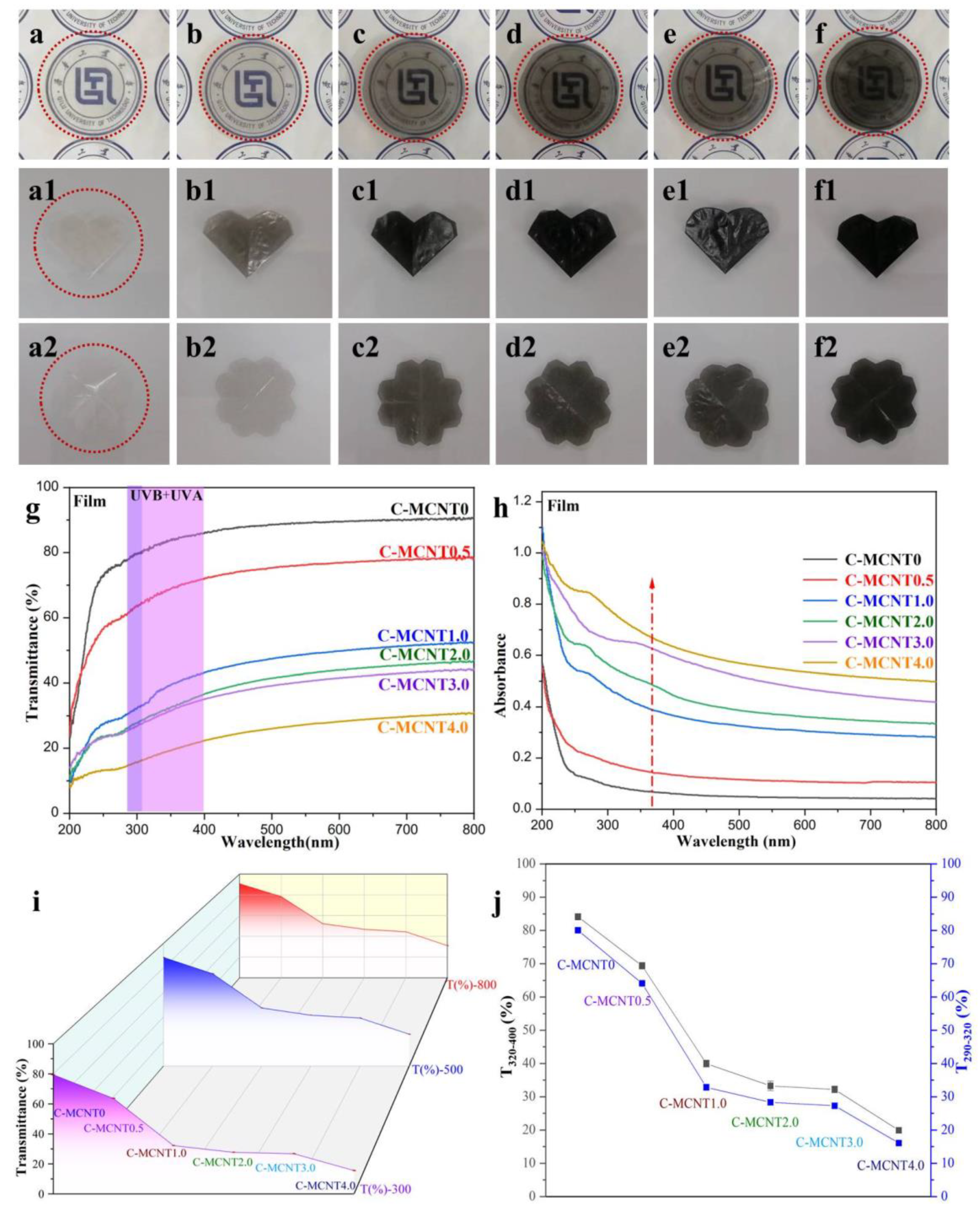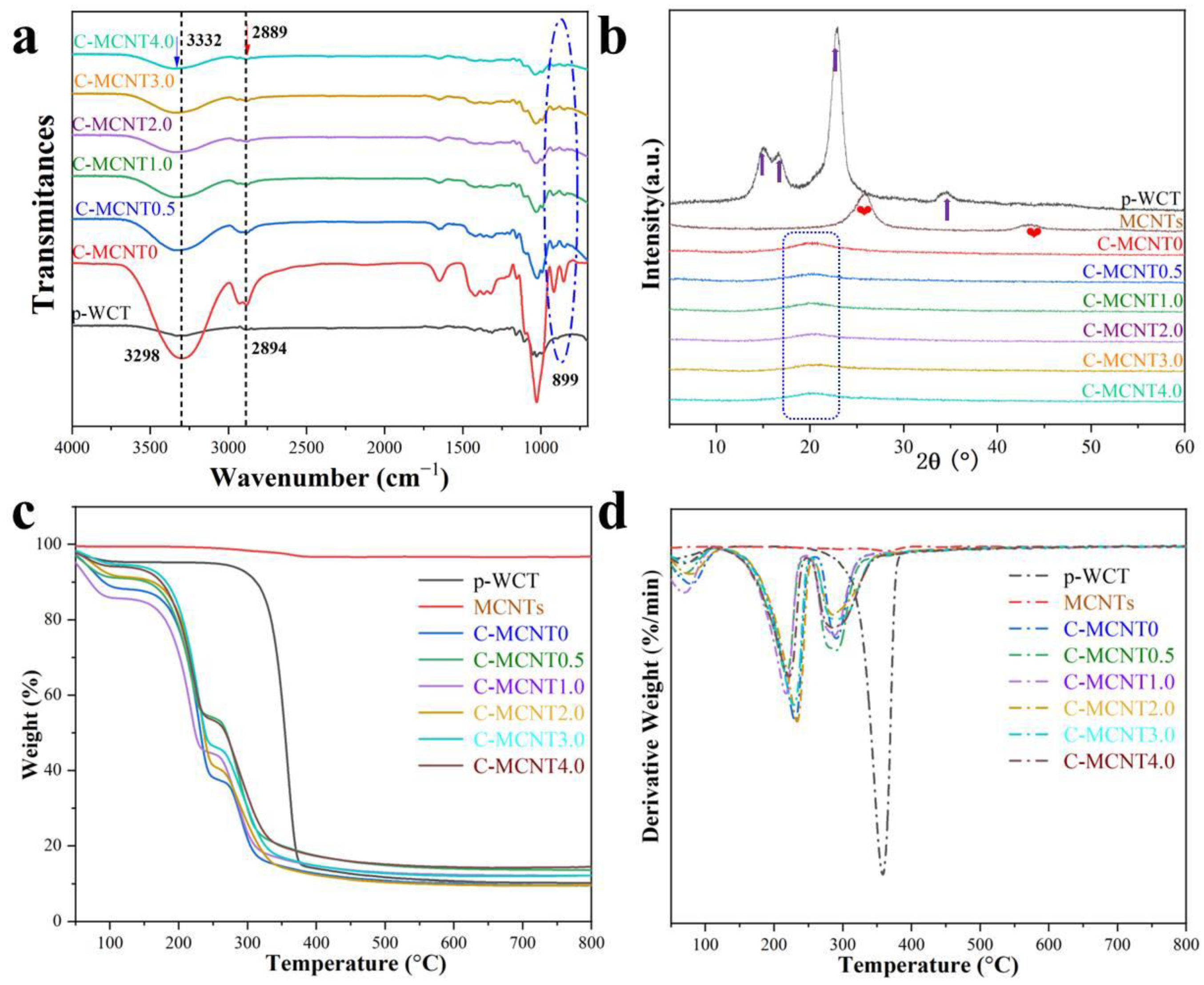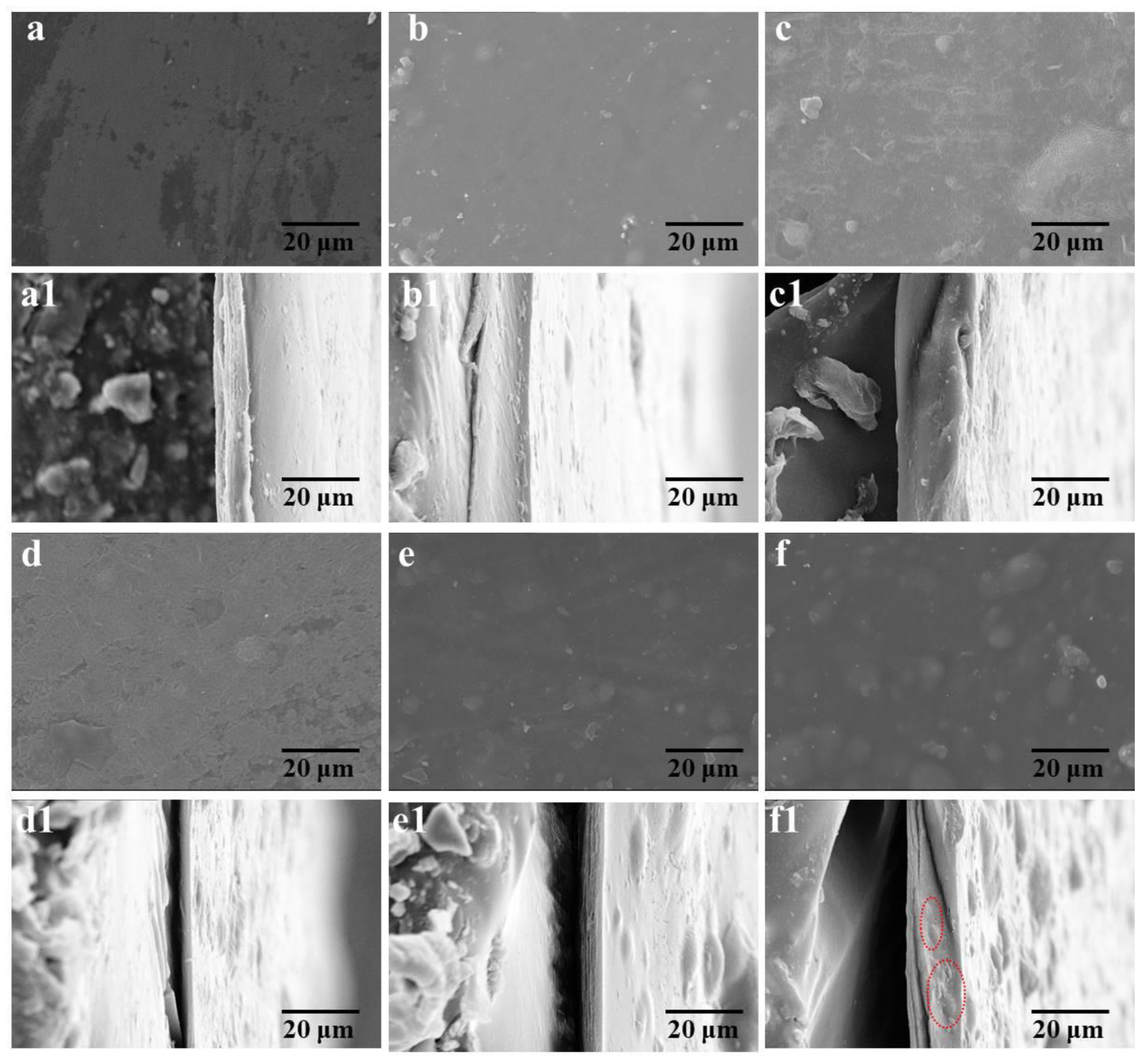Transparent Cellulose/Multi-Walled Carbon Nanotube Hybrids with Improved Ultraviolet-Shielding Properties Prepared from Cotton Textile Waste
Abstract
:1. Introduction
2. Materials and Methods
2.1. Materials and Chemicals
2.2. Fabrication of Cellulose/MCNT Composites
2.3. Characterization
2.3.1. Ultraviolet and Visible (UV-Vis) Spectra of the Cellulose/MCNT Composites
2.3.2. Wide-Angle X-ray Diffraction (WAXD) of p-WCT, MCNTs, C-MCNT0, C-MCNT0.5, C-MCNT1.0, C-MCNT2.0, C-MCNT3.0, and C-MCNT4.0
2.3.3. The Wettability of C-MCNT0, C-MCNT0.5, C-MCNT1.0, C-MCNT2.0, C-MCNT3.0, and C-MCNT4.0
2.3.4. Fourier-Transform Infrared (FTIR) Spectra of p-WCT, MCNTs, C-MCNT0, C-MCNT0.5, C-MCNT1.0, C-MCNT2.0, C-MCNT3.0, and C-MCNT4.0
2.3.5. Micro-Structures of the Cellulose/MCNT Films
2.3.6. Thermogravimetric Analysis (TGA) of p-WCT, MCNTs, C-MCNT0, C-MCNT0.5, C-MCNT1.0, C-MCNT2.0, C-MCNT3.0, and C-MCNT4.0
2.3.7. Mechanical Tests of C-MCNT0, C-MCNT0.5, C-MCNT1.0, C-MCNT2.0, C-MCNT3.0, and C-MCNT4.0
3. Results and Discussion
3.1. Stability of Cellulose/MCNT Mixtures
3.2. Transparency and Ultraviolet–Visible Spectra of Cellulose/MCNT Hydrogels
3.3. Transparency and Ultraviolet–Visible Spectra of Cellulose/MCNT Films
3.4. FTIR, XRD, and TGA of Cellulose/MCNT Films
3.5. Mechanical Properties and Wettability of Cellulose/MCNT Hybrid Films
3.6. Micro-Structures of the Cellulose/MCNT Films
4. Conclusions
Author Contributions
Funding
Institutional Review Board Statement
Informed Consent Statement
Data Availability Statement
Acknowledgments
Conflicts of Interest
References
- Liu, S.; Wang, J. Exploring the potential of cellulose benzoate adsorbents modified with carbon nanotubes and magnetic carbon nanotubes for microplastic removal from water. Chem. Eng. J. 2023, 469, 143910. [Google Scholar] [CrossRef]
- Jin, M.; Sun, M.; Liu, J.; Dong, C.; Xue, J. Influence of operating parameters on the yield of micro-plastics from plastics incineration. Sci. Total Env. 2024, 912, 169347. [Google Scholar] [CrossRef] [PubMed]
- Geyer, R.; Jambeck, J.R.; Law, K.L. Production, use, and fate of all plastics ever made. Sci. Adv. 2017, 3, e1700782. [Google Scholar] [CrossRef] [PubMed]
- Pegado, T.; Andrades, R.; Noleto-Filho, E.; Franceschini, S.; Soares, M.; Chelazzi, D.; Russo, T.; Martellini, T.; Barone, A.; Cincinelli, A.; et al. Meso- and microplastic composition, distribution patterns and drivers: A snapshot of plastic pollution on Brazilian beaches. Sci. Total Environ. 2024, 907, 167769. [Google Scholar] [CrossRef] [PubMed]
- Kaing, V.; Guo, Z.; Sok, T.; Kodikara, D.; Breider, F.; Yoshimura, C. Photodegradation of biodegradable plastics in aquatic environments: Current understanding and challenges. Sci. Total Environ. 2024, 911, 168539. [Google Scholar] [CrossRef] [PubMed]
- MacLeod, M.; Arp, H.P.H.; Tekman, M.B.; Jahnke, A. The global threat from plastic pollution. Science 2021, 373, 61–65. [Google Scholar] [CrossRef]
- Singh, N.; Mondal, A.; Bagri, A.; Tiwari, E.; Khandelwal, N.; Monikh, F.A.; Darbha, G.K. Characteristics and spatial distribution of microplastics in the lower Ganga River water and sediment. Mar. Pollut. Bull. 2021, 163, 111960. [Google Scholar] [CrossRef] [PubMed]
- Zhang, Q.Q.; Lan, M.Y.; Li, H.R.; Qiu, S.Q.; Guo, Z.; Liu, Y.S.; Zhao, J.L.; Ying, G.G. Plastic pollution from takeaway food industry in China. Sci. Total Environ. 2023, 904, 166933. [Google Scholar] [CrossRef]
- Panda, P.K.; Sadeghi, K.; Seo, J. Recent advances in poly (vinyl alcohol)/natural polymer based films for food packaging applications: A review. Food Packag. Shelf Life 2022, 33, 100904. [Google Scholar] [CrossRef]
- Bekchanov, D.; Mukhamediev, M.; Yarmanov, S.; Lieberzeit, P.; Mujahid, A. Functionalizing natural polymers to develop green adsorbents for wastewater treatment applications. Carbohydr. Polym. 2024, 323, 121397. [Google Scholar] [CrossRef]
- Xia, G.; Ji, X.; Xu, Z.; Ji, X. Transparent cellulose-based bio-hybrid films with enhanced anti-ultraviolet, antioxidant and antibacterial performance. Carbohydr. Polym. 2022, 298, 120118. [Google Scholar] [CrossRef] [PubMed]
- Heng, W.; Weihua, L.; Bachagha, K. Review on design strategies and applications of flexible cellulose-carbon nanotube functional composites. Carbohydr. Polym. 2023, 321, 121306. [Google Scholar] [CrossRef] [PubMed]
- Yavuzturk Gul, B.; Pekgenc, E.; Vatanpour, V.; Koyuncu, I. A review of cellulose-based derivatives polymers in fabrication of gas separation membranes: Recent developments and challenges. Carbohydr. Polym. 2023, 321, 121296. [Google Scholar] [CrossRef]
- Xie, S.; Zhao, J.; Zhang, B.; Wang, Z.; Ma, H.; Yu, C.; Yu, M.; Li, L.; Li, J. Graphene Oxide Transparent Hybrid Film and Its Ultraviolet Shielding Property. ACS Appl. Mater. Interfaces 2015, 7, 17558–17564. [Google Scholar] [CrossRef] [PubMed]
- Zhang, X.F.; Song, L.; Wang, Z.; Wang, Y.; Wan, L.; Yao, J. Highly transparent graphene oxide/cellulose composite film bearing ultraviolet shielding property. Int. J. Biol. Macromol. 2020, 145, 663–667. [Google Scholar] [CrossRef]
- Mahdavian, M.; Yari, H.; Ramezanzadeh, B.; Bahlakeh, G.; Hasani, M. Immobilization of ultraviolet absorbers on graphene oxide nanosheets to be utilized as a multifunctional hybrid UV-blocker: A combined density functional theory and practical application. Appl. Surf. Sci. 2018, 447, 135–151. [Google Scholar] [CrossRef]
- Huang, J.; Lu, Z.; Li, J.; Ning, D.; Jin, Z.; Ma, Q.; Hua, L.; Songfeng, E.; Zhang, M. Improved mechanical and ultraviolet shielding performances of hydroxyethyl cellulose film by using aramid nanofibers as additives. Carbohydr. Polym. 2021, 255, 117330. [Google Scholar] [CrossRef] [PubMed]
- Xia, G.; Zhou, Q.; Xu, Z.; Zhang, J.; Zhang, J.; Wang, J.; You, J.; Wang, Y.; Nawaz, H. Transparent cellulose/aramid nanofibers films with improved mechanical and ultraviolet shielding performance from waste cotton textiles by in-situ fabrication. Carbohydr. Polym. 2021, 273, 118569. [Google Scholar] [CrossRef]
- Zheng, T.; Yang, L.; Zhang, X.-F.; Yao, J. Conversion of corncob residue to sustainable lignin/cellulose film with efficient ultraviolet-blocking property. Ind. Crops Prod. 2023, 196, 116517. [Google Scholar] [CrossRef]
- Kim, J.C.; Kim, J.; Cho, Y.M.; Cho, S.M.; Hwang, S.W.; Kwak, H.W.; Yeo, H.; Choi, I.G. Fabrication of transparent cellulose nanofibril composite film with smooth surface and ultraviolet blocking ability using hydrophilic lignin. Int. J. Biol. Macromol. 2023, 245, 125545. [Google Scholar] [CrossRef]
- Wang, K.; Liu, K.; Dai, L.; Si, C. Bioinspired multiscale cellulose/lignin-silver composite films with robust mechanical, antioxidant and antibacterial properties for ultraviolet shielding. Int. J. Biol. Macromol. 2023, 258 Pt 2, 129046. [Google Scholar] [CrossRef] [PubMed]
- Wu, X.; Lian, H.; Li, X. An ultraviolet shielding material based on lignin nanoparticles engineered with deep eutectic solvents for long-term outdoor application. J. Clean. Prod. 2023, 430, 139694. [Google Scholar] [CrossRef]
- Zhang, S.; Fu, Q.; Li, H.; Li, Y.; Wu, P.; Ai, S. Polydopamine-coated lignin nanoparticles in polysaccharide-based films: A plasticizer, mechanical property enhancer, anti-ultraviolet agent and bioactive agent. Food Hydrocoll. 2024, 147, 109325. [Google Scholar] [CrossRef]
- Miraftab, R.; Ramezanzadeh, B.; Bahlakeh, G.; Mahdavian, M. An advanced approach for fabricating a reduced graphene oxide-AZO dye/polyurethane composite with enhanced ultraviolet (UV) shielding properties: Experimental and first-principles QM modeling. Chem. Eng. J. 2017, 321, 159–174. [Google Scholar] [CrossRef]
- Pandiyarasan, V.; Archana, J.; Pavithra, A.; Ashwin, V.; Navaneethan, M.; Hayakawa, Y.; Ikeda, H. Hydrothermal growth of reduced graphene oxide on cotton fabric for enhanced ultraviolet protection applications. Mater. Lett. 2017, 188, 123–126. [Google Scholar] [CrossRef]
- Tian, M.; Hu, X.; Qu, L.; Du, M.; Zhu, S.; Sun, Y.; Han, G. Ultraviolet protection cotton fabric achieved via layer-by-layer self-assembly of graphene oxide and chitosan. Appl. Surf. Sci. 2016, 377, 141–148. [Google Scholar] [CrossRef]
- Babaahmadi, V.; Montazer, M. Reduced graphene oxide/SnO2 nanocomposite on PET surface: Synthesis, characterization and application as an electro-conductive and ultraviolet blocking textile. Colloids Surf. A Physicochem. Eng. Asp. 2016, 506, 507–513. [Google Scholar] [CrossRef]
- Kausar, A.; Ahmad, I. Highpoints of carbon nanotube nanocomposite sensors—A review. e-Prime-Adv. Electr. Eng. Electron. Energy 2024, 7, 100419. [Google Scholar] [CrossRef]
- Naief, M.F.; Mohammed, S.N.; Mohammed, A.M. Carbon nanotubes: A review on synthesis and drug delivery for cancer treatment. Inorg. Chem. Commun. 2024, 159, 111694. [Google Scholar] [CrossRef]
- Ijaz, H.; Mahmood, A.; Abdel-Daim, M.M.; Sarfraz, R.M.; Zaman, M.; Zafar, N.; Alshehery, S.; Salem-Bekhit, M.M.; Ali, M.A.; Eltayeb, L.B.; et al. Review on carbon nanotubes (CNTs) and their chemical and physical characteristics, with particular emphasis on potential applications in biomedicine. Inorg. Chem. Commun. 2023, 155, 111020. [Google Scholar] [CrossRef]
- Idumah, C.I. Recent advancements in fire retardant mechanisms of carbon nanotubes, graphene, and fullerene polymeric nanoarchitectures. J. Anal. Appl. Pyrolysis 2023, 174, 106113. [Google Scholar] [CrossRef]
- Ahmad, J.; Zhou, Z. Properties of concrete with addition carbon nanotubes: A review. Constr. Build. Mater. 2023, 393, 132066. [Google Scholar] [CrossRef]
- Donchak, V.; Stetsyshyn, Y.; Bratychak, M.; Broza, G.; Harhay, K.; Stepina, N.; Kostenko, M.; Voronov, S. Nanoarchitectonics at surfaces using multifunctional initiators of surface-initiated radical polymerization for fabrication of the nanocomposites. Appl. Surf. Sci. Adv. 2021, 5, 100104. [Google Scholar] [CrossRef]
- Cai, Y.; Wang, Y.; Cheng, L.; Guo, S.; Liu, T.; Hu, Z.; Yu, H.; Chen, D.; Li, Y.; Yuan, H. Structure design and assembly mode of carbon nanotube-based flexible electrode materials and flexible supercapacitors. J. Energy Storage 2023, 73, 109179. [Google Scholar] [CrossRef]
- Li, M.; Xu, Q.; Zhang, Y.; Kong, W.; Wang, Y.; Zhang, G.; Gao, H.; Liu, L.; Ge, A. Thermoplastic polyurethane foams derived from cellulose nanofibril/carbon nanotube/(Fe/C) aerogels for efficient electromagnetic interference shielding. Ind. Crops Prod. 2024, 209, 117938. [Google Scholar] [CrossRef]
- Kausar, A.; Ahmad, I. Conducting Polymer Nanocomposites for Electromagnetic Interference Shielding—Radical Developments. J. Compos. Sci. 2023, 7, 240. [Google Scholar] [CrossRef]
- Li, H.; Zong, Y.; He, J.; Ding, Q.; Jiang, Y.; Li, X.; Han, W. Wood-inspired high strength and lightweight aerogel based on carbon nanotube and nanocellulose fiber for heat collection. Carbohydr. Polym. 2022, 280, 119036. [Google Scholar] [CrossRef] [PubMed]
- Zhang, H.; Wang, Z.G.; Zhang, Z.N.; Wu, J.; Zhang, J.; He, J.S. Regenerated-Cellulose/Multiwalled- Carbon-Nanotube Composite Fibers with Enhanced Mechanical Properties Prepared with the Ionic Liquid 1-Allyl-3-methylimidazolium Chloride. Adv. Mater. 2007, 19, 698–704. [Google Scholar] [CrossRef]
- Fukushima, T.; Kosaka, A.; Ishimura, Y.; Yamamoto, T.; Takigawa, T.; Ishii, N.; Aida, T. Molecular ordering of organic molten salts triggered by single-walled carbon nanotubes. Science 2003, 300, 2072–2074. [Google Scholar] [CrossRef]
- Zhang, H.; Wu, J.; Zhang, J.; He, J. 1-Allyl-3-methylimidazolium Chloride Room Temperature Ionic Liquid: A New and Powerful Nonderivatizing Solvent for Cellulose. Macromolecules 2005, 38, 8272–8277. [Google Scholar] [CrossRef]
- Xia, G.; Han, W.; Xu, Z.; Zhang, J.; Kong, F.; Zhang, J.; Zhang, X.; Jia, F. Complete recycling and valorization of waste textiles for value-added transparent films via an ionic liquid. J. Environ. Chem. Eng. 2021, 9, 106182. [Google Scholar] [CrossRef]
- Zhang, J.; Luo, N.; Wan, J.; Xia, G.; Yu, J.; He, J.; Zhang, J. Directly Converting Agricultural Straw into All-Biomass Nanocomposite Films Reinforced with Additional in Situ-Retained Cellulose Nanocrystals. ACS Sustain. Chem. Eng. 2017, 5, 5127–5133. [Google Scholar] [CrossRef]






| Sample | Cellulose (%) | MCNTs (%) |
|---|---|---|
| C-MCNT0 | 100 | 0 |
| C-MCNT0.5 | 99.5 | 0.5 |
| C-MCNT1.0 | 99.0 | 1.0 |
| C-MCNT2.0 | 98.0 | 2.0 |
| C-MCNT3.0 | 97.0 | 3.0 |
| C-MCNT4.0 | 96.0 | 4.0 |
Disclaimer/Publisher’s Note: The statements, opinions and data contained in all publications are solely those of the individual author(s) and contributor(s) and not of MDPI and/or the editor(s). MDPI and/or the editor(s) disclaim responsibility for any injury to people or property resulting from any ideas, methods, instructions or products referred to in the content. |
© 2024 by the authors. Licensee MDPI, Basel, Switzerland. This article is an open access article distributed under the terms and conditions of the Creative Commons Attribution (CC BY) license (https://creativecommons.org/licenses/by/4.0/).
Share and Cite
Xu, Z.; Ma, Y.; Yao, X.; Wang, H.; Zhang, Q.; Ma, Q.; Zhang, Z.; Xia, G.; Zhang, J.; Zhang, F. Transparent Cellulose/Multi-Walled Carbon Nanotube Hybrids with Improved Ultraviolet-Shielding Properties Prepared from Cotton Textile Waste. Polymers 2024, 16, 1269. https://doi.org/10.3390/polym16091269
Xu Z, Ma Y, Yao X, Wang H, Zhang Q, Ma Q, Zhang Z, Xia G, Zhang J, Zhang F. Transparent Cellulose/Multi-Walled Carbon Nanotube Hybrids with Improved Ultraviolet-Shielding Properties Prepared from Cotton Textile Waste. Polymers. 2024; 16(9):1269. https://doi.org/10.3390/polym16091269
Chicago/Turabian StyleXu, Zhen, Yingying Ma, Xiaohui Yao, Hongxu Wang, Qian Zhang, Qiance Ma, Zhanrui Zhang, Guangmei Xia, Jinming Zhang, and Fengshan Zhang. 2024. "Transparent Cellulose/Multi-Walled Carbon Nanotube Hybrids with Improved Ultraviolet-Shielding Properties Prepared from Cotton Textile Waste" Polymers 16, no. 9: 1269. https://doi.org/10.3390/polym16091269





